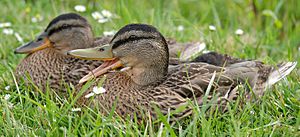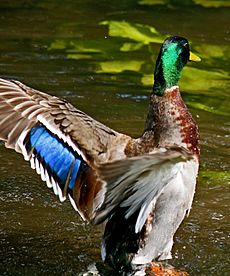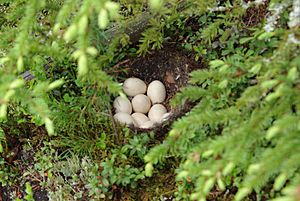Mallard facts for kids
Quick facts for kids Mallard |
|
|---|---|
 |
|
| Mallard female (front) and male (rear) | |
| Conservation status | |
| Scientific classification | |
| Kingdom: | |
| Phylum: | |
| Class: | |
| Order: | |
| Family: | |
| Subfamily: | |
| Genus: |
Anas
|
| Species: |
A. platyrhynchos
|
| Binomial name | |
| Anas platyrhynchos |
|
The Mallard (Anas platyrhynchos) is a very well-known duck. You can find it in many parts of the world, including North America, Europe, Asia, New Zealand, and Australia. It's the most common duck around! Mallards live almost anywhere there's water, like wetlands, even in city areas.
Contents
What Mallards Look Like
Mallards are medium-sized waterfowl. They are usually 50 to 65 cm (20 to 26 in) long. Their wings can spread out to 81 to 98 cm (32 to 39 in). A Mallard typically weighs between 0.72 and 1.58 kg (1.6 and 3.5 lb).
Male and Female Differences
Male Mallards are easy to spot, especially during breeding season. They have a shiny, bottle-green head and a white ring around their neck. Their chest is a brownish-purple, their wings are grey-brown, and their belly is pale grey. The back of the male is black, with dark tail feathers that have white edges. The male's bill is yellowish-orange with a black tip.
Female Mallards look different. They are mostly mottled brown, meaning their feathers have a mix of light and dark brown. This helps them blend in with their surroundings. Their bill is usually darker, from black to mixed orange and brown. Females have buff-colored cheeks, throat, and neck, with a darker crown and a stripe near their eye.
Both male and female Mallards have special shiny purple-blue feathers on their wings. These are called speculum feathers and have white edges. You can see them when the duck flies or rests. They lose these feathers temporarily during their summer molt.
From Duckling to Adult
When a Mallard duckling first hatches, it has yellow fur on its belly and face. It has black fur on its back and head, with some yellow spots. Its legs and bill are black.
As the duckling gets older, its feathers start to look more like the female's, but with more streaks. Its legs also lose their dark color. By two months old, the duckling is a juvenile. When it's three to four months old, its wings are fully grown, and it can start to fly. At this age, you can see the purple speculum feathers.
You can tell the sex of a juvenile Mallard by looking at three things:
- Males have a yellow bill, while females have a black and orange bill.
- Male chest feathers are reddish-brown, but female chest feathers are brown.
- Male Mallards have a curled feather in the center of their tail, called a drake feather. Females have a straight tail feather.
As male juveniles grow into adults (between 6 and 10 months), their feathers slowly change to their bright, adult colors. Adult males also change their feathers during summer. They get a duller "eclipse plumage" before returning to their bright breeding colors. Mallards are considered adults at 14 months old. They usually live for about three years, but some can live up to 20 years!
Sounds Mallards Make
Female Mallards make the classic "quack" sound that most people think of when they hear a duck. Male Mallards also "quack," but their sound is deeper and rougher. It can also sound like "breeeeze."
When a female is sitting on her nest or has ducklings, she makes a shorter "quack" sound. If her nest or ducklings are in danger, she will hiss. When Mallards take off into flight, their wings make a soft whistling noise.
Where Mallards Live
Mallards live all over the world, in both the Northern and Southern parts. In North America, they live from Alaska down to Mexico and the Hawaiian Islands. In Europe and Asia, they are found from Iceland and Greenland all the way to Japan and South Korea. They also live in Australia and New Zealand.
Mallards that live in northern areas often migrate south for the winter. For example, in North America, they fly to the southern United States and northern Mexico. They can even go as far as Central America and the Caribbean between September and May.
Mallards can live in many different places and climates, from cold Arctic areas to warm subtropical regions. They are found in both fresh and salty water, like parks, ponds, rivers, lakes, and estuaries. They also like shallow coastal waters. They prefer water that is less than 0.9 metres (3.0 ft) deep and are drawn to places with lots of water plants.
Mallard Behavior
How Mallards Find Food
Mallards eat many different things. They are omnivorous, meaning they eat both plants and animals. What they eat can change based on the time of year, what food is available, and if other animals are competing for food.
Most of a Mallard's diet includes small water creatures like snails, insects (such as beetles, flies, and dragonflies), and worms. They also eat many kinds of seeds, plant parts, and roots. During breeding season, females who are laying eggs eat more animal matter. At other times, plants make up a larger part of their diet, especially in autumn and winter.
Mallards usually find food by "dabbling." This means they tip their bodies forward in the water, keeping their tail up, to reach plants and small creatures just below the surface. They have also been seen eating frogs. In one unusual case, a group of Mallards in Romania was seen hunting and eating small birds!
Outside of breeding season, Mallards like to be in large groups, called "sords."
Reproduction and Life Cycle
Mallards usually form pairs in the autumn (October and November in the Northern Hemisphere). The female then lays her eggs when spring begins.
A female Mallard lays between 8 and 13 eggs. The eggs are creamy white to greenish-buff and have no spots. They are about 58 mm (2.3 in) long and 32 mm (1.3 in) wide. She lays one egg every other day. She starts to sit on the eggs (this is called incubation) when almost all the eggs have been laid.
Incubation takes 27 to 28 days. The ducklings are able to swim as soon as they hatch! They stay close to their mother for warmth, protection, and to learn about their home and how to find food. It takes 50 to 60 days for the ducklings to grow enough to fly (this is called fledging). Once they can fly, they learn their family's migration routes.
During breeding season, both male and female Mallards can become aggressive. They will chase away other ducks that come too close to their mate or nest. Males often fight each other by pecking at the chest and pulling out feathers.
Dangers and Threats
Mallards, especially young ones, face many predators. These include birds of prey (like hawks and eagles), weasels, crows, snakes, raccoons, opossums, skunks, turtles, large fish, cats, and dogs. The main predators of adult Mallards are red foxes and larger birds of prey like peregrine falcons and eagles.
Other animals that might attack Mallards include grey herons, large gulls, and big fish like wels catfish and northern pike. Crows are also known to kill ducklings and sometimes even adult ducks. Larger waterfowl like swans and geese can also attack Mallards during breeding season if they feel their territory or offspring are threatened. Mute swans have even been known to kill Mallards.
Mallards have a special way to stay safe while sleeping. They can sleep with one eye open, which means half of their brain stays awake and aware of danger. This behavior is common in many birds.
Mallards and People
Mallards as Pets and Farm Animals
Mallards have lived near humans for a long time. You can often see them in parks, on farms, and in other places with water. Almost all types of domestic ducks (ducks kept by humans) come from the Mallard, except for a few Muscovy breeds.
Wild Mallards usually have one mate, but domestic ducks often have many. Domestic ducks are also less aggressive than wild Mallards. People mostly keep domestic ducks for their meat, as their eggs have a strong flavor. Ducks were first kept by humans over 4,000 years ago in Southeast Asia.
It's common for wild Mallards to mate with domestic ducks. Their offspring are healthy and can have their own babies. This means that wild Mallards can sometimes have genes from domestic ducks.
Hunting Mallards
Mallards are a popular duck for hunting. Hunters often look for them in shallow water. Hunting can sometimes cause the Mallard population to go down in certain areas. In some countries, it's legal to hunt Mallards, but there are rules about how and when it can be done to protect them.
Mallards as Food
People have eaten Mallards since ancient times. In ancient Greece, wild Mallards were a food source. Usually, only the breast and thigh meat are eaten. Mallard meat is often cooked by braising (cooking slowly in liquid) or roasting. Sometimes, it's flavored with bitter orange or port wine.
Images for kids
-
An American black duck (upper left) and a male Mallard (lower right) in eclipse plumage
-
A male mute swan (Cygnus olor) chasing away a female Mallard
See also
 In Spanish: Ánade real para niños
In Spanish: Ánade real para niños














